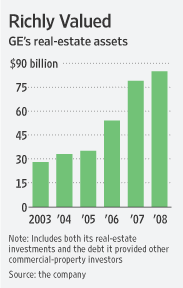Investors in General Electric Co. will get a more detailed picture of what the world’s largest landlord holds in its commercial real-estate portfolio when GE’s finance arm updates investors on its businesses and financials Thursday.
But the disclosure mightn’t ease doubts about whether the Fairfield, Conn., conglomerate is owning up to the potential losses it faces from those investments.
Other companies have been clobbered by steep declines in the value of office buildings, apartments, stores, hotels and other commercial property. The Dow Jones REIT index has slid 60% in the past 12 months. Private-equity firms that specialize in real estate are reporting losses of as much as 60% for funds invested recently.
GE has been much more generous in its approach to its holdings. So far, GE has said its $34 billion in property could fall in value by about 1.5% this year, amounting to a pretax loss of as much as $500 million.

Comments »When values were rising, real estate used to be a major earnings machine for GE’s finance arm. By selling a few buildings, the company could immediately recognize profits. But, with the sales market at a virtual standstill, profits are plummeting and the risk of losses is increasing.
A GE spokesman declined to answer questions about the company’s real-estate portfolio, citing plans to make an “in-depth public presentation” Thursday. But in the past GE executives have said that, under accounting rules, the company doesn’t have to “mark to market” its real-estate holdings as other investors do. In other words, the company doesn’t have to value its properties at what they would be worth if they were sold today.
Why? GE says because properties are long-term investments, the company should book losses in terms of potential drops in cash flows and their expected long-term decline in value. Also, about 80% of its real-estate holdings were purchased with cash and have no mortgages. That means that, unlike other highly leveraged property investors, GE runs very little risk of having to sell properties to pay off creditors.
But many on Wall Street believe GE’s approach doesn’t sufficiently recognize the damage the recession is doing to commercial real estate, which is expected to get steadily worse. Last week, GE lost the triple-A credit rating it first achieved more than five decades ago, as Standard & Poor’s lowered its view on GE’s long-term debt by one notch, to double-A-plus. The bond-rating firm cited, among other concerns, GE’s “large exposure” to commercial real estate in light of “mounting strains” in this sector.
Moreover, GE may still be too optimistic even using its more-conservative approach for estimating losses, analysts say. Looking at cash flow and long-term declines in value, the company’s portfolio may lose a lot more than $500 million, they say.
“If commercial real-estate prices are down between 20% and 30% from the peak, it’s not too hard to see that the downside could be a lot more than $500 million,” said analyst Richard Hofmann at CreditSights.
Cash flow is a big problem right now for landlords, including GE, because vacancies are rising and rents are falling at nearly unprecedented rates.
Nationwide, as job losses accelerated, vacancies at office towers increased 0.8 percentage point to 14.5% in the fourth quarter, the largest one-quarter jump since the second quarter of 2001, and likely will rise to 16.7% this year, according to research firm Reis Inc. in New York.
Office and retail leases can run for as many as 15 years, meaning that landlords that sign deals today are locking in lower rents — and lower values — for the long term.
Also, GE’s portfolio is vulnerable to steeper losses partly because the company bought so much at the top of the market. According to Real Capital Analytics, a research firm in New York, GE sold $7 billion of real estate world-wide in 2007 but acquired $16.6 billion that frothy year.
Some of GE’s 2007 deals appear to be turkeys. For example, in July 2007, GE bought nine office complexes in Chicago from Blackstone Group LP for $1.05 billion. Those properties had been owned by Equity Office Properties, which Blackstone acquired for $39 billion at the beginning of 2007 and then sold off in large chunks. Vacancy is rising at most of those properties, according to real estate firms.
At Oakbrook Terrace Tower, a prominent 31-story building that is close to the finest shopping and restaurants in suburban Chicago, the vacancy rate has jumped to 33% today from about 16% at the time GE bought the property, according to CoStar Group Inc.
Overall, vacancies at the Equity Office properties acquired by GE have risen to more than 25% from 19%, according to the real-estate research firm in Bethesda, Md.
In the Chicago market, almost half of the office buildings showed rent declines in the fourth quarter.
“We have never seen this kind of marked acceleration in the number of office properties willing to lower rents to prevent further deterioration in occupancy,” says Reis research director Victor Calanog.
In his annual letter to shareholders, GE Chief Executive Jeffrey Immelt offered a frank view on the company’s real-estate holdings: “Today, I wish we had less exposure to commercial real estate.”
